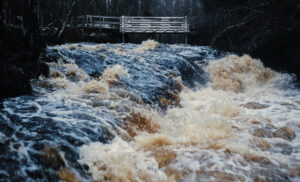Atmospheric Rivers
What is an Atmospheric River?
An atmospheric river is a thin, concentrated stream of moisture or vapor that carries roughly the equivalent amount of water as the average flow at the mouth of the Mississippi River, which is a lot! The river moves with the weather until it encounters an obstacle such as the coast range in California. The river then rises up and over the mountains causing these vapors to cool and condense as it gain altitude, making the moisture heavy, so the river releases it in the form of rain, or snow. Smaller atmospheric rivers produce beneficial rain and snow that feeds our watersheds, while larger ones produce extreme rain which causes floods, mudslides and other weather related damage.
California was hit with a significant atmospheric river on Friday October 22, 2021.
 California was hit with a significant atmospheric river on Friday October 22, 2021, combined with a bomb cyclone weather event. This resulted in high levels of rain falling in a short amount of time (sometimes over 9 inches in under 72 hours and a record-breaking 5 inches in Sacramento), causing localized flooding, evacuation warnings, power outages, and mudslides throughout large portions of the state. These high rain events can be particularly dangerous to those living around areas recently burned in Northern California, including the Caldor, River, and Dixie Fires. Warmer, wetter storms like this are expected to happen with more frequency and intensity as we experience the impacts of the climate crisis.
California was hit with a significant atmospheric river on Friday October 22, 2021, combined with a bomb cyclone weather event. This resulted in high levels of rain falling in a short amount of time (sometimes over 9 inches in under 72 hours and a record-breaking 5 inches in Sacramento), causing localized flooding, evacuation warnings, power outages, and mudslides throughout large portions of the state. These high rain events can be particularly dangerous to those living around areas recently burned in Northern California, including the Caldor, River, and Dixie Fires. Warmer, wetter storms like this are expected to happen with more frequency and intensity as we experience the impacts of the climate crisis.
What Does This Mean for California?
With that much water, is California no longer in a drought?
Unfortunately, no. Just like the average person who needs eight glasses of water a day to stay hydrated, California’s rivers and watersheds benefit from precipitation consistently throughout California’s wet season in order to get out of extreme drought and sustain healthy resilient ecosystems. While this weekend’s storm did provide some much-needed rainfall which will help quell risk of catastrophic wildfire in Northern California, it did not significantly contribute to the state’s major reservoirs – more rain and runoff would be needed.
This means the major dams in California are not releasing more water, which means no additional water for the majority of California’s rivers for now. Finally, this storm did not meaningfully help recharge our state’s depleted drinking water source – groundwater aquifers. Many generous rainy seasons would be needed to do that.
Would more dams and reservoirs help us capture that additional rainfall in future storms?
No. First, we already have over a thousand major dams and reservoirs in the state that can hold a lot of water. We also have a lot of empty groundwater basins that need replenishment.
While atmospheric rivers provide water for the rivers, people, and landscapes of California, they can also be a threat. California has a number of aging dams that can be challenged by floodwaters generated by atmospheric rivers. This could potentially cause damage to dams and flood control works, such as what happened at the Oroville spillway in 2017 and Northern California levee breaks in the 1986 and 1997 storms. Our state has not made the investments in the aging water infrastructure, such as dam safety upgrades, levees, secondary spillways, and floodplain restoration, needed to prepare for the impacts of climate change.
What Is Friends of the River Doing to Respond to These Issues?
Friends of the River is actively engaged in commenting with a group of diverse stakeholders on the draft Central Valley Flood Protection Plan, calling for better flood protection management—especially for communities already impacted and vulnerable to climate change. Friends of the River is also reviewing key policy documents such as the draft California Climate Adaptation Strategy to ensure healthy rivers are valued in statewide climate strategy.
On a broader level, Friends of the River is also advocating for resilient urban and wildland water solutions which could help our state and communities adaptively respond to such storms. Resilient water solutions include recycled water and stormwater capture for urban areas, and green infrastructure investment such as floodplain and meadow restoration that utilizes storm water floods into natural groundwater recharge, like in river parkways.
Conservation and preservation of our lands and waters must be prioritized.
